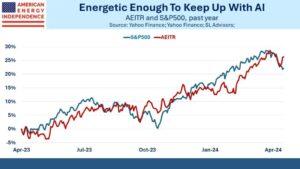As global tensions escalate following the U.S. downing of four flying objects, including at least one surveillance balloon from China, global economic growth is buckling under the strain of monetary policy tightening. While slowing growth is helping to curtail historically high levels of price increases, Russia’s recent decision to reduce oil production may end the recent reprieve from high energy costs that has helped lower headline inflation.
U.S. markets advanced this morning after a significant selloff last week. The S&P 500 Index was up approximately 77 basis points (bps), bonds yields rose modestly at the short-end while dipping slightly at the long-end, crude oil remained roughly unchanged and the U.S. dollar index dropped roughly 23 bps.
In recent weeks, international tensions have become increasingly more significant for investor sentiment. The February 4 U.S. downing of a Chinese spy balloon was followed by U.S. Secretary of State Antony Blinken postponing his diplomatic trip to China. The Chinese government responded by claiming the balloon was a civilian research airship and called the U.S. downing of the vessel “an unacceptable and irresponsible action.” China also claimed the U.S. has sent balloons into its airspace. As tensions have simmered, the U.S. and Canada have shot down three other objects of unknown identity. The balloon conflict adds to existing tensions about China’s military potentially cracking down on Taiwan, China’s trade policies and China’s refusal to condemn the Russian invasion of Ukraine.
Tensions resulting from the Russian invasion are also poised to create new shockwaves across the global economy. As a retaliation against countries that have imposed sanctions targeting Russia, the country announced it will cut oil production by 500,000 barrels a day in March, causing the price of crude oil to jump more than 2%. Prior to the Russia announcement, the IMF upgraded its outlook for 2023 global economic growth from its October forecast of 2.7% to 2.9% while also increasing its forecast for core price increases. Many central banks, meanwhile, have opined that we are only in the early phases of the inflation battle.
In a favorable development, S&P Global Ratings gave a favorable nod to the Reserve Bank of India last Tuesday when it said the central bank’s policy tightening has resulted in sequential declines in inflation and further rate hikes may be unnecessary. The next day, the central bank announced it would hold its current standing deposit facility interest rate at 6.25% but increase its benchmark rate 25 bps to 6.5%. The country’s retail inflation rate as measured by the consumer price index dropped to 5.7% in December, a one-year low, primarily a result of declining food prices.
Bank of England (BoE) policymakers, however, are debating the future of monetary policy tightening. Last week, Silvana Tenreyro, an external member of the Bank’s Monetary Policy Committee (MPC), said inflation is all but guaranteed to come down significantly this year, but she cautioned that an unforeseen development, such as an energy shock, could derail this view. Her view may be an outlier with other MPC members maintaining that the bank must continue to act forcefully to fight inflation and BoE Chief Economist Huw Pill says potential upside risk to inflation remains, despite the labor market appearing to weaken. The BoE recently raised the Bank Rate 50 basis points to 4%. Inflation in December fell to a still high rate of 10.5% after having peaked at 11.1%, for now.
Inflation is still sticky in many other countries and regions, including the eurozone, Australia and the U.S. while the re-opening of the Chinese economy is creating more uncertainty about price pressures, especially with energy commodities.
- European Central Bank policymaker Klaas Knot on Wednesday cautioned that if core inflation persists, the central bank may need to continue its interest rate hikes into May. In early February, the bank increased its interest rate 50 bps and disclosed it expects to increase rates another 50 bps in March while continuing to reduce its balance sheet. Its bank deposit interest rate is now 2.50%. By many measures, the euro zone economy is slowing, but it’s unclear how much work is required to curtail inflation. The S&P Global Eurozone Construction PMI rose to 46.1 in January 2023 after hitting a 31-month low of 42.6 in December. While still depicting weakness, the index declined at its slowest rate in seven months. The ECB has also released survey results showing that the median inflation expectation among consumers over the next three years rose to 3% in December from 2.9% in November, even as energy prices moderated due in large part to a mild winter reducing demand for heating oil. Euro area annualized inflation recently hit an eight-month low of 8.5%, dropping from 9.2% in January.
- Australia is also maintaining a hawkish approach, announcing on February 7 that it is raising its cash target rate 25 bps to 3.35%. The country’s y/y inflation rate in December was 7.8%, its highest rate since 1990. The bank attributes price increases to global developments but acknowledges that strong domestic demand is also a factor.
- The U.S., meanwhile, revised its December estimated CPI to show that prices during the month had increased rather than declined, and separately, the University of Michigan’s Consumer Sentiment report showed that individuals are increasingly concerned about inflation. Those releases came shortly after a surprisingly strong jobs report: The U.S. added 517,000 jobs in January and unemployment fell to 3.4%, the lowest rate in 53 years. The combination of those three data points is likely to strengthen the Federal Reserve’s stance that tighter monetary policy needs to extend further into the future.
Asia, furthermore, is a huge wildcard with China reopening its economy and the Bank of Japan installing a new central bank leader.
- China’s economy could grow 5% this year, according to Fitch Ratings, which previously estimated that the country’s GDP would increase only 4.1%. Fitch believes consumption in the country is occurring faster than previously anticipated. The country’s Purchasing Manager’s Index (PMI) for manufacturing rose to 50.1 in January and to 54.4 for services, reaching highs not seen since June of last year. Anything above 50 implies expansions of activities. Consumers who are unsure about future Covid-19 policies have stockpiled a considerable amount of cash that could support strong spending, economic growth and higher prices in the coming months.
- Japan is also being watched carefully as the country prepares to install Kazuo Ueda as the Bank of Japan’s governor, replacing Haruhiko Kuroda. Ueda is an economist who previously served on the bank’s policy board. On Friday, he said under current circumstances, monetary policy loosening is appropriate. The news alleviated fears that the bank may have a strong inflation hawk as a new governor and sparked the yen to lose some ground. Japan’s economy is feeling the effects of a slowing global economy caused by central banks’ monetary policy tightening. The country’s leading economic indicator for December declined to 97.2 from a November reading of 97.7.
As countries worldwide struggle to arrest price increases, the International Monetary Fund has revised its global inflation forecast upward. In April it expected headline and core inflation this spring to hit slightly over 7% and 5%, respectively but its most recent estimate has been revised to approximately 9% and 7%. It believes advanced economies will grow, on average, 1.2% compared to 2.7% in 2022. Emerging markets and developing economies will grow 4%, up slightly from 2022’s 3.9% rate.
Market participants are patiently awaiting tomorrow’s pivotal U.S. CPI report. The report is expected to show broad based price increases across energy, food, goods and services. At the moment, the equity market hasn’t reacted to the bond market’s dramatic repricing of the Fed’s higher for longer path. Tomorrow’s report may lead to a realignment of the equity and bond markets. I’m expecting to see a sizzling number with the headline up 0.6% and core up 0.5% month-over-month while the year-over-year figure comes in at 6.4%.
Disclosure: Interactive Brokers
Information posted on IBKR Campus that is provided by third-parties does NOT constitute a recommendation that you should contract for the services of that third party. Third-party participants who contribute to IBKR Campus are independent of Interactive Brokers and Interactive Brokers does not make any representations or warranties concerning the services offered, their past or future performance, or the accuracy of the information provided by the third party. Past performance is no guarantee of future results.
This material is from IBKR Macroeconomics and is being posted with its permission. The views expressed in this material are solely those of the author and/or IBKR Macroeconomics and Interactive Brokers is not endorsing or recommending any investment or trading discussed in the material. This material is not and should not be construed as an offer to buy or sell any security. It should not be construed as research or investment advice or a recommendation to buy, sell or hold any security or commodity. This material does not and is not intended to take into account the particular financial conditions, investment objectives or requirements of individual customers. Before acting on this material, you should consider whether it is suitable for your particular circumstances and, as necessary, seek professional advice.
Disclosure: Futures Trading
Futures are not suitable for all investors. The amount you may lose may be greater than your initial investment. Before trading futures, please read the CFTC Risk Disclosure. A copy and additional information are available at ibkr.com.










![[Gamma] Scalping Please [Gamma] Scalping Please](https://ibkrcampus.com/wp-content/smush-webp/2024/04/tir-featured-8-700x394.jpg.webp)
![[Gamma] Scalping Please [Gamma] Scalping Please](https://ibkrcampus.com/wp-content/uploads/2024/04/tir-featured-8-700x394.jpg)














